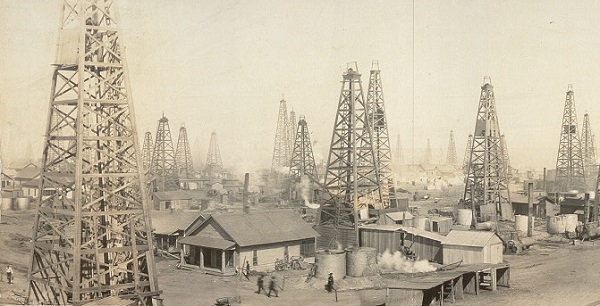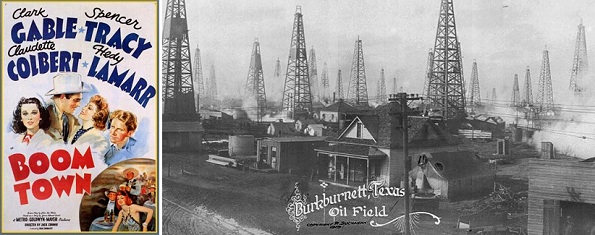“The World’s Wonder Oil Pool” in North Texas attracted investors, drillers — and Hollywood.
The July 1918 Burkburnett oilfield discovery on a small farm along the Red River in Texas launched a drilling boom that brought great prosperity to North Texas. It was just the beginning. Less than one year later, a well on another farm added 27 square miles to the oilfield, bringing even more exploration and production companies to Wichita County.
Even as oil exploration expanded throughout Texas after the headline-making gusher at Spindletop in 1901, few companies believed the geology along the Red River at Burkburnett could produce oil. S.L. Fowler thought otherwise, so he and his brother organized the Fowler Farm Oil Company with W.D. Cline and J.I. Staley.
Discovery Well
On July 29, 1918, the company’s Fowler No. 1 well revealed a massive oilfield beneath the small town of Burkburnett. News of the discovery launched another North Texas exploration boom just one year after the “Roaring Ranger” oil gusher in nearby Eastland County.

Detail of circa 1919 photo by A. Newman Photographic Company with railroad tank cars at Burkburnett, Texas, “the world’s wonder oil pool, showing eight months phenomenal development, viewed from the northwest side, opposite Fowler farm.” Image courtesy Library of Congress.
News of Wichita County’s new oilfield brought more drilling and well service companies, including cementing experts like young Erle Halliburton of Duncan, Oklahoma. The excitement also inspired an MGM movie starring Clark Gable, who at the time toiled as a teenage roughneck in Oklahoma oilfields.
Fowler’s well discovered an oilfield at the northeastern edge of Burkburnett, which had been founded in 1907. The cotton-farming town (once called Nesterville) had been renamed by President Theodore Roosevelt, who had hunted wolves along the Red River with prominent local rancher Burk Burnett.

A detail from “General view, Burkburnett oilfield” panoramic gelatin silver print (9 inches x 95 inches) courtesy Library of Congress Prints and Photographs Division.
Although Wichita County had been producing oil since 1912, thanks to a shallow water well discovery west of Wichita Falls, Fowler’s decision to drill on his farm had been called “Fowler’s Folly.” His oilfield discovery brought hundreds of oil companies rushing into the county.

Burkburnett, featured in a 1940 Hollywood movie, earlier had transformed from a sleepy North Texas farm town into a small city on the Red River. Poster courtesy MGM. Oilfield photo courtesy Burkburnett Historical Society.
Fifty-six drilling rigs were at work just three weeks after the original oil strike at a depth of 1,734 feet. By end of 1918, the Burkburnett population had swelled to 8,000 people — and a line of derricks two-miles long greeted new arrivals. Burkburnett oilfield wells were producing 7,500 barrels per day. Then the field grew even bigger.
Northwest Extension
On April 17, 1919, another exploratory well drilled on a Wichita County farm, the Bob Waggoner No. 1 well, erupted and began producing 4,800 barrels of oil a day. The latest North Texas oil discovery became known as the Northwest Extension Oilfield, according to the Wichita County Historical Commission.
The oilfield addition included about 27 square miles on the former S. Burk Burnett Wild Horse Ranch. “R.M. ‘Bob’ Waggoner’s well led to a boom, and the area was suddenly thick with oil derricks,” the commission noted in a 2004 historical marker.
By June 1919, newspapers nationwide proclaimed more than 850 North Texas oil wells produced oil from “the World’s Wonder Oilfield.”

A collection of 1930s oilfield photography by Farm Security Administration photographers can be found at Library of Congress Prints and Photographs Division.
Nineteen operating refineries in Wichita Falls processed the flood of crude oil. New service companies, brokerage houses, and other businesses added offices along the town’s unpaved streets. Photographers came to shoot derricks — and autos stuck in the mud.
The Burkburnett oilfield joined earlier discoveries in nearby Electra (1911) and Ranger (1917) that helped make North Texas a worldwide leader in petroleum production. Twenty trains ran daily between Burkburnett and Wichita Falls until the boom began to fade at the approach of the Great Depression.
Hollywood Boom Town
As its petroleum industry declined, Burkburnett’s population fell throughout the 1930s. By 1939, the town had a population of less than 3,500. At the same time, the movie “Boom Town” resulted from the adaptation of a Cosmopolitan magazine article, “A Lady Comes to Burkburnett.”
The 1940 MGM feature starred Spencer Tracy and Clark Gable, Hedy Lamarr and Claudette Colbert — and received two nominations for Academy Awards. At the time of the 1918 Burkburnett discovery well, Clark Gable worked as a 17-year-old roustabout with his father, William Gable, a service contractor, in an oilfield outside Bigheart, Oklahoma.

The popular 1940 movie resulted from a Cosmopolitan magazine article, “A Lady Comes to Burkburnett,” based on the 1918 oilfield discovery.
In 1922, Gable would collect an inheritance from his grandfather and leave working in the Oklahoma oil patch for good. His father reportedly said, “I told the stubborn mule if he left me this time, he need never come back.”
By 2000, the Burkburnett population exceeded 10,000, thanks to agriculture, continued production from its historic oilfield — and the 1941 establishment of nearby Sheppard Air Force Base.
Tourist attractions include the MK&T Depot (Missouri–Kansas–Texas railroad) that served Burkburnett throughout the oil boom. Originally built for the Wichita and Northwestern Railway line, MK&T in 1915 purchased the depot, a Burkburnett Historical Society museum in 2018.
Additional local attractions include the Red River Riding Association’s Boomtown Rodeo every July, and a petroleum equipment museum founded by a local oil producer.
Family Oil Museum
In the 1970s, Burkburnett independent producer Francis “F.T.” Felty Sr. decided the giant oilfield’s history deserved to be preserved. His collection of equipment originated during World War II, when he established an oilfield service company during the revival of North Texas drilling.

F.T. Felty Jr. in 2005 maintained his collection of antique “spudders” from the North Texas oil boom first collected by his father for the family’s Felty Outdoor Oil Museum of Burkburnett. Photo by Bruce Wells.
Responding to the war’s steel shortages, Felty had crisscrossed oilfields in a truck pulling used casings. The difficult work gave way to a long career as an oil and natural gas operator.
Felty began his outdoor museum collection with portable “spudders” and added other vintage oilfield equipment. His son Francis “F.T.” Felty Jr. and other family members have continued preserving North Texas petroleum history for local school children.
Learn more in Felty Outdoor Oil Museum.
Wichita Falls Skyscraper Shaft
High-resolution panoramic photographs of the historic oilfield can be found at the Library of Congress Prints and Photographs Division’s Burkburnett, Texas, “the world’s wonder oil pool, showing 8 months phenomenal development.”
A footnote of the North Texas oil boom is the “World’s Littlest Skyscraper” in Wichita Falls. Just 40 feet tall with 118 square feet per floor, it has survived since 1919.
The building is a monument of the boom town era — and a Philadelphia con man who convinced oilmen (who were desperate for office space) to approve fraudulent blueprints. J. D. McMahon disappeared after collecting $200,000 and completing his promised “skyscraper.” The contract’s fine print overlooked by investors noted a scale measured in inches, not feet.
“Apparently too busy to keep an eye on construction, investors ultimately found themselves owners of a building that looked more like an elevator shaft than high-rise office space,” explained Carlton Stowers, the 2008 author of “Legend of the World’s Littlest Skyscraper.”
“The completed building’s outside dimensions were a closet-sized 11 feet by 19 feet. Stairwells that led to the upstairs floors occupied 25 percent of the interior,” Stower noted. “Dallas and Houston may have sparkling skyscrapers so tall that they require oxygen in the penthouses, but has Ripley’s Believe It or Not ever paid them attention?”
The brick building has become a Wichita Falls landmark. Today it attracts oil-patch knowledgeable tourists. The city is also headquarters for the Texas Alliance of Energy Producers.
_______________________
Recommended Reading: Early Texas Oil: A Photographic History, 1866-1936 (2000); Texas Oil and Gas, Postcard History Series (2013); Wildcatters: Texas Independent Oilmen
(1984). Your Amazon purchase benefits the American Oil & Gas Historical Society. As an Amazon Associate, AOGHS earns a commission from qualifying purchases.
_______________________
The American Oil & Gas Historical Society (AOGHS) preserves U.S. petroleum history. Please become an AOGHS annual supporter and help maintain this energy education website and expand historical research. For more information, contact bawells@aoghs.org. © 2025 Bruce A. Wells.
Citation Information – Article Title: “Boom Town Burkburnett.” Authors: B.A. Wells and K.L. Wells. Website Name: American Oil & Gas Historical Society. URL: https://aoghs.org/petroleum-pioneers/burkburnett-oil. Last Updated: July 28, 2025. Original Published Date: April 29, 2015.




